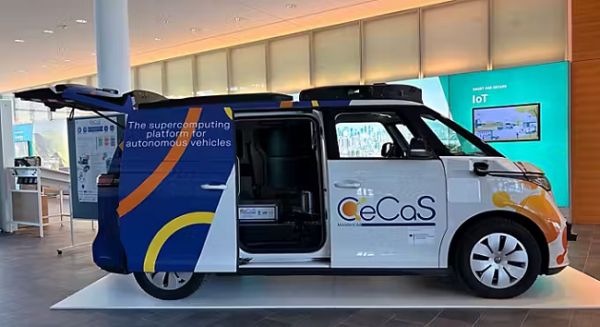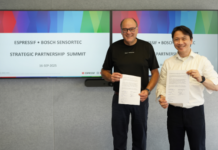
Highlights:
- Powerful supercomputing platform controls software and hardware for safe, highly automated vehicles
- 28 leading partners developed vehicle demonstrator “Made in Germany” in the Mannheim-Central Car Server (CeCaS) research project
- Results strengthen leading position of German industry and research and promote Germany’s technological sovereignty in autonomous driving
As cars become increasingly connected, intelligent and autonomous, they require powerful compute architectures with multi-gigabit interfaces. In a joint effort, 28 research partners from industry and science have now presented a new supercomputer made in Germany, the demonstrator of a central computing platform for the automotive industry that meets highest safety and reliability standards. Led by Infineon Technologies AG, the partners developed this platform over the past three years in a research project called Mannheim-CeCaS (Central Car Server). The project was supported by the German Federal Ministry of Research, Technology and Space (BMFTR), with a project volume of 88.2 million euros, making it one of the BMFTR’s largest national automotive research projects. The demonstrator was presented at the project closing event in Munich, successfully demonstrating its functionality while integrated in a modern electric car.
“The results of the Mannheim-CeCaS project are a significant step towards the mobility of the future – this is where research and innovation meet the road,” says Frank Badstübner, spokesperson for the Mannheim-CeCaS project management team, Infineon Technologies AG, adding: “The energy and cost-efficient high-performance computing platform developed jointly in the consortium is standardized, modular and scalable. This demonstrates impressively how we, together with excellent partners from industry and science, contribute to the innovative strength of the German automotive industry in global competition.”
Powerful supercomputer
The aim of the Mannheim-CeCaS project was to develop a powerful and real-time capable supercomputer for level 3 to 5 autonomous driving. The project consortium worked to design the processors, interfaces and system architectures. A flexible software environment has been specially adapted to the requirements of the latest algorithms in cars, particularly for the use of artificial intelligence (AI). These developments are crucial to making autonomous driving a safe and efficient reality.
Centrally controlled and modular platform for many vehicle types
The Mannheim-CeCaS team has bundled the vehicle’s intelligence into a central hardware and software architecture instead of using many separate control units. This results in less complexity and more efficiency, while the platform itself remains flexible and can be easily adapted to meet new requirements. Future modules can be easily retrofitted without having to redevelop the entire vehicle. This centralized solution enables faster development and easier adaptations for different vehicle sizes, performance classes and functions.
Zone-based management
The various modules are regulated simultaneously via one computing node. This includes safety-critical systems such as the engine, transmission and brakes as well as on-board cameras, parking aids, temperature and distance sensors, motors for power windows and seat adjustment, air conditioning and on-board entertainment. Thanks to the new zonal architecture, the vehicle is also lighter as fewer cables are required. The architecture also reduces energy consumption, which has a positive effect on the range of electric cars. The research team used Ethernet-based technology to enable real-time communication between the components. Despite the huge volume of data, the Mannheim-CeCaS system remains extremely flexible and scalable. In addition, the vehicle’s software can be updated over-the-air, eliminating the need to go to the workshop for updates.
Demonstrator in nine months
Using a cost-optimized rapid prototyping approach, the team succeeded in implementing and validating the zone-based demonstrator in just nine months. The complete automotive qualification at system level was prepared. The knowledge gained can also be used in modular chiplet technologies or RISC-V-based application processors. This underlines the versatility and relevance of the results from the project for future technologies.
German cutting-edge research: 28 partners from industry and science
The Mannheim-CeCaS project, led by Infineon Technologies AG, brought together 28 partners and ran for a total of three years. The project volume of 88.2 million euros was supported by investments from industry as well as 52 percent co-funding from the German Federal Ministry of Research, Technology and Space (BMFTR) under the “MANNHEIM” funding guideline as part of the “Future Fund for the Automotive Industry”.
The project partners (in alphabetical order):
- Ambrosys GmbH, Potsdam
- Aumovio SE, Frankfurt am Main
- AVL Software and Functions GmbH, Regensburg
- Berliner Nanotest und Design GmbH, Berlin
- CARIAD SE – Automotive Software for Volkswagen, Wolfsburg
- emmtrix Technologies GmbH, Karlsruhe
- Fraunhofer ENAS, Chemnitz
- Fraunhofer IPMS, Dresden
- Fraunhofer IMWS, Halle/Saale
- Fraunhofer IZM, Berlin
- FZI Forschungszentrum Informatik, Karlsruhe
- Glück Engineering GmbH, Neckartailfingen
- Hella GmbH & Co. KGaA, Lippstadt
- HM Hochschule München University of Applied Sciences, Munich
- INCHRON AG, Erlangen
- Infineon Technologies AG, München
- Infineon Technologies Semiconductor GmbH, Langen
- Karlsruhe Institute of Technology (KIT), Karlsruhe
- Kernkonzept GmbH, Dresden
- Missing Link Electronics GmbH, Neu-Ulm
- Robert Bosch GmbH, Schwieberdingen
- Swissbit Germany AG, Berlin
- STTech GmbH, Munich
- Technical University of Munich (TUM)-
- Chemnitz University of Technology
- Universität zu Lübeck
- Steinbeis Transfer Center Heat Management in Electronics (ZFW), Walddorfhäslach
- ZF Friedrichshafen AG, Friedrichshafen
For more information, visit Project Website: www.mannheim-cecas.de

















